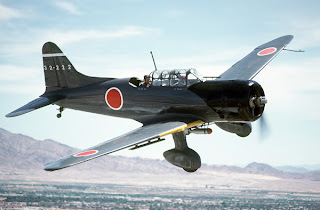
Production of the D4Y1-C continued in small numbers until March 1943, when the increasing losses incurred by the D3A resulted in production switching to the D4Y1 dive-bomber, the aircraft's structural problems finally being solved. Although the D4Y could operate successfully from the large and fast fleet carriers that formed the core of the Combined Fleet at the start of the war, it had problems operating from the smaller and slower carriers such as the Hiyō class which formed a large proportion of Japan's carrier fleet after the losses received in the Battle of Midway. Catapult equipment was therefore fitted, giving rise to the D4Y-1 Kai model.
The last version was the D4Y4 Special Strike Bomber. This one-seat kamikaze aircraft, capable of carrying one 800 kg (1,760 lb) bomb, was put into production in February 1945. It was equipped with three RATO boosters for terminal dive acceleration. This aircraft was an almost ideal kamikaze model: it had a combination of speed (560 km/h/350 mph), range (2,500 km/1,550 mi) and payload (800 kg/1,760 lb) probably not matched by any other Japanese aircraft.

The D4Y5 Model 54 was a planned version designed in 1945. It was to be powered by the Nakajima NK9C Homare 12 radial engine rated at 1,361 kW (1,825 hp), would have a new four-blade metal propeller of the constant-speed type, and would have more armour protection for the crew and fuel tanks. Ultimately, 2,038 of all variants were produced, mostly by Aichi.
The D4Y was actually faster than the A6M Zero. Some were employed as D4Y2-S night fighters against the high flying B-29 Superfortress bombers late in the war, a unique role for a single-engine dive bomber. The night fighter conversions were made at the 11th Naval Aviation Arsenal at Hiro. Each D4Y2-S had all bomb equipment removed and a 20 mm Type 99 Model 2 cannon with its barrel slanting up and forwards (similar to the German Schräge Musik system) installed in place of the gunner's cockpit. However, the lack of radar for night operations and slow climb rate, combined with the B-29's high ceiling, made the D4Y2-S ineffective as a night fighter. Little is known of their operations.
General characteristics
- Crew: two
- Length: 33 ft 6 in (10.22 m)
- Wingspan: 37 ft 9 in (11.50 m)
- Height: 12 ft 3 in (3.74 m)
- Wing area: 254 ft² (23.6 m²)
- Empty weight: 5,379 lb (2,440 kg)
- Loaded weight: 9,370 lb (4,250 kg)
- Powerplant: 1× Aichi Atsuta AE1P 32 liquid-cooled inverted V12 piston engine, 1,044 kW (1,400 hp)
Performance
- Maximum speed: 550 km/h (342 mph)
- Range: 1,465 km (910 mi)
- Service ceiling: 10,700 m (35,105 ft)
- Rate of climb: 14 m/s (2,700 ft/min)
- Wing loading: 180 kg/m² (37 lb/ft²)
- Power/mass: 0.25 kW/kg (0.15 hp/lb)
Armament
- 2× forward-firing 7.7 mm machine guns
- 1× rearward-firing 7.92 mm machine gun
- 500 kg (1,102 lb) of bombs (design), 800 kg (1,764 lb) of bombs
** Yokosuka D4Y Suisei - Warbird Fare








 8/29/2011
8/29/2011
 Warbirdfare
Warbirdfare


















